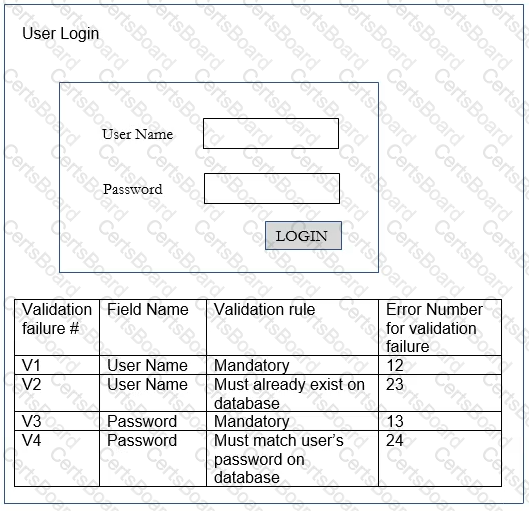Which of the following factors will MOST affect the testing effort required to test a software product? [K1]
A test score indicator for students produces a performance score based on a combination of the number of consecutive hours studied (below 4 hours. 4 to 8 hours. 9 to 12 hours or above 12 hours) and the average intensity of focus on the material during the study time (low, medium or high). Given the following test cases:

What Is the minimum number of additional test cases that are needed to ensure full coverage of all valid INPUT equivalence partitions?
Which defect below is MOST likely to be found by a review during static testing?
You are performing a review of your colleague’s test cases based on the following test basis document:

The Test Cases are as follows:
TC1. Success – valid ‘User Name’ and ‘Password’; Customer Menu displayed
TC2. Failure – ‘User Name’ field has blank entry; Error Number 12 displayed
TC3. Failure – ‘User Id’ entered does not exist on database (i.e. unregistered user); Error Number 23 displayed
TC4. Failure – ‘Password’ entered does not match user’s password on database; Error Number 24 displayed
You are guided by the following checklist in your review:
C1. There must be one test case to cover success
C2. There must be one test case for each error path (e.g. validation failure)
C3. Each test case must use terminology consistent with the test basis document (field names, error numbering, etc.)
Record a separate defect for each missing test case (checklist items C1 and C2) and for each test case that does not meet checklist item C3.
How many defects should you record?
Which of the following options BEST explain the pesticide paradox principle of testing?
Which test design technique can be used for effectively testing system requirements consisting of logical conditions?
Which one of the following is an example of how product risk analysis can influence the testing approach?
Which of the following are triggers for Maintenance testing?
a) System migration from one platform to another.
b) Retirement of a system.
c) Preparation for an audit of a system.
d) Modifications to a system.
e) Development of a whole new system.
What type of test design technique is the most effective in testing screen-dialog flows?


